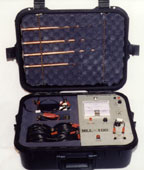Hello ~
Doris of Kellyco has made this recommendation:
http://www.kellycodetectors.com/gpl/ground.htm
Detection depths:
GPL 100 -- 50 feet
GPL 200 -- 100 feet
GPL 8 -- 200 feet
She then referred me to JW of Kellyco who said this:
Bill,
Either the eXp 4000 with the super sensor option, or the eXp 5000 with the super sensor would be your best choice.http://www.kellycodetectors.com/okm/okmmain.htm Click on the link to see the two devices.
Regards,
JW
And, in the meantime, this has been recommended to me:
Super Sting 8 resistivity equipment from Advanced Geoscience inc. www.agiusa.com
There may be a possibility that I can rent the Super String 8 here in the Philippines. If this does not turn out to be the case, do you think that the GPL 8 may be suitable to fit our needs here?
Thanks & Best Regards ~
Bill
Doris of Kellyco has made this recommendation:
http://www.kellycodetectors.com/gpl/ground.htm
Detection depths:
GPL 100 -- 50 feet
GPL 200 -- 100 feet
GPL 8 -- 200 feet
She then referred me to JW of Kellyco who said this:
Bill,
Either the eXp 4000 with the super sensor option, or the eXp 5000 with the super sensor would be your best choice.http://www.kellycodetectors.com/okm/okmmain.htm Click on the link to see the two devices.
Regards,
JW
And, in the meantime, this has been recommended to me:
Super Sting 8 resistivity equipment from Advanced Geoscience inc. www.agiusa.com
There may be a possibility that I can rent the Super String 8 here in the Philippines. If this does not turn out to be the case, do you think that the GPL 8 may be suitable to fit our needs here?
Thanks & Best Regards ~
Bill


Comment